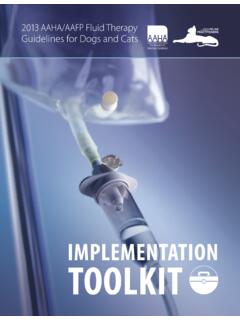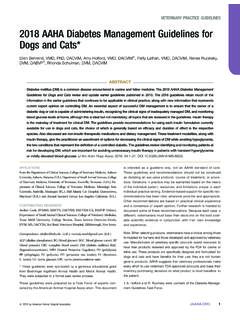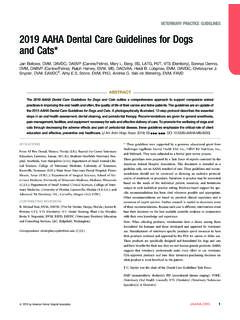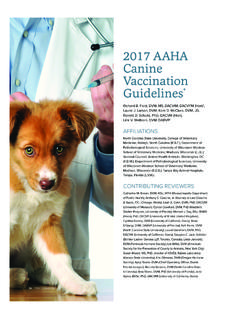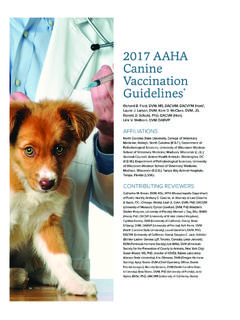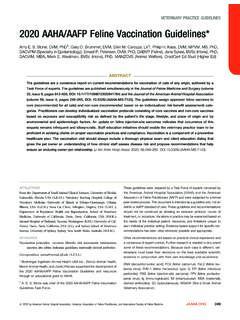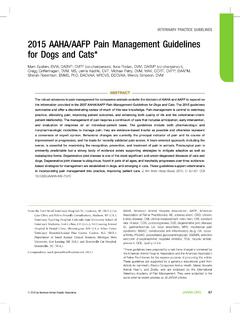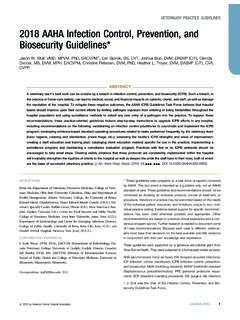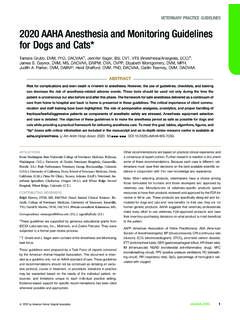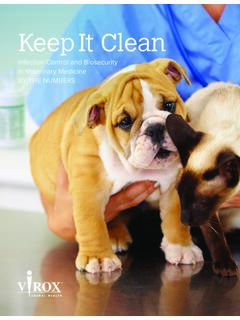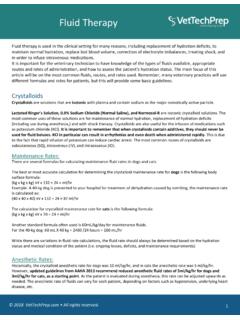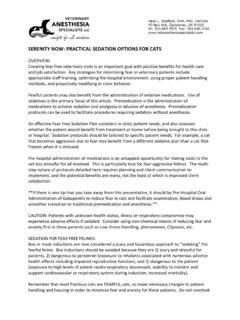Transcription of AAHA Anesthesia Guidelines for Dogs and Cats*
1 VETERINARY PRACTICE GUIDELINESAAHA Anesthesia Guidelines for Dogs and Cats* Richard Bednarski, MS, DVM, DACVA (Chair), Kurt Grimm, DVM, MS, PhD, DACVA, DACVCP,Ralph Harvey, DVM, MS, DACVA, Victoria M. Lukasik, DVM, DACVA, W. Sean Penn, DVM, DABVP (Canine/Feline),Brett Sargent, DVM, DABVP (Canine/Feline), Kim Spelts, CVT, VTS, CCRP ( Anesthesia )ABSTRACTSafe and effective Anesthesia of dogs and cats rely on preanesthetic patient assessment and preparation. Patients should bepremedicated with drugs that provide sedation and analgesia prior to anesthetic induction with drugs that allow endotrachealintubation. Maintenance is typically with a volatile anesthetic such as isoflurane or sevoflurane delivered via an endotrachealtube. In addition, local anesthetic nerve blocks; epidural administration of opioids; and constant rate infusions of lidocaine,ketamine, and opioids are useful to enhance analgesia.
2 Cardiovascular, respiratory, and central nervous system functions arecontinuously monitored so that anesthetic depth can be modified as needed. Emergency drugs and equipment, as well as anaction plan for their use, should be available throughout the perianesthetic period. Additionally, intravenous access and crys-talloid or colloids are administered to maintain circulating blood volume. Someone trained in the detection of recovery abnor-malities should monitor patients throughout recovery. Postoperatively attention is given to body temperature, level of sedation,and appropriate analgesia.(J Am Anim Hosp Assoc2011; 47:377 385. DOI )There are no safe anesthetic agents, there are no safe anesthetic are only safe anesthetists. Robert Smith, MDaIntroductionThe purpose of this article is to provide Guidelines for anesthetizingdogs and cats, which can be used daily in veterinary practice.
3 Thiswill add to the existing family of american animal hospital As- sociation ( aaha ) guidelinesband other references, such as theanesthesia monitoring Guidelines published by the AmericanCollege of Veterinary Anesthesiologists (ACVA) article includes recommendations for preanesthetic patientevaluation and examination, selection of premedication, inductionand maintenance drugs, monitoring, equipment, and recognition of differences among practices, these Guidelines arenot meant to establish a universal anesthetic plan or legal standardof EvaluationThe preanesthetic patient evaluation identifies individual riskfactors and underlying physiologic challenges that contribute in-formation for development of the anesthetic plan. Factors to beevaluated include the following: History: Identify risk factors, including responses to previousanesthetic events, known medical conditions, and previous ad-verse drug responses.
4 Identify all prescribed and over-the-countermedications (including aspirin) and supplements to avoid ad-verse drug Physical examination: A thorough physical examination mayreveal risk factors, such as heart murmur and/or arrhythmiaor abnormal lung the Veterinary Medical Center, The Ohio State University,Columbus, OH ( ); Veterinary Specialist Services PC, Conifer,CO ( ); Department of Small animal Clinical Sciences, Universityof Tennessee College of Veterinary Medicine, Knoxville, TN ( );Southwest Veterinary Anesthesiology, Southern Arizona VeterinarySpecialists, Tucson, AZ ( ); Phoenix, AZ ( ); Front RangeVeterinary Clinic, Lakewood, CO ( ); and Peak Performance Veter-inary Group, Colorado Springs, CO ( )Correspondence: ( )AAHAA merican animal hospital Association;ACVAA merican College ofVeterinary Anesthesiologists;ASAA merican Society of Anesthesiologists;AVMAA merican Veterinary Medical Association;ETendotracheal;PLITPro-fessi onal Liability Insurance Trust*This report was prepared by a task force of experts convened by theAmerican animal hospital Association for the express purpose of producingthis article.
5 This report was sponsored by an educational grant from AbbottAnimal Health, and was subjected to the same external review process asare all ofJournal of american animal hospital Associationarticles. 2011 by american animal hospital Age: Advanced age can increase anesthetic risk because ofchanges in cardiovascular and respiratory function. Disease pro-cesses occur more commonly in aged patients. Very youngpatients can be at increased risk from hypoglycemia, hypother-mia, and decreased drug metabolism. Breed: Few breed-specific Anesthesia issues are dogs and cats are more prone to upper airwayobstruction. Greyhounds have longer sleep times after receivingsome anesthetics such as propofol or thiopentald. Some breeds ofdogs ( , Cavalier King Charles spaniel) and cats ( , Mainecoon) may be predisposed to cardiac disease as they Temperament: An aggressive or fractious temperament maypose a danger to staff and can limit the preanesthetic evaluationor make examination impossible.
6 The selection of an alterna-tive preanesthetic drug or drug combination may be requiredfor the aggressive or overly fearful animal due to the need forhigher-than-usual drug doses. Conversely, a quiet or depressedanimal may benefit from lower doses for sedation or Anesthesia . Type of procedure: Evaluate the procedure s level of invasiveness,anticipated pain, risk of hemorrhage, and/or predisposition tohypothermia. Some procedures may limit physical access to thepatient for monitoring. Using heavy sedation versus general Anesthesia : This choicedepends on the procedure, patient temperament, and the needfor monitoring and support. In general, sedation may be ap-propriate for shorter (,30 min) and less-invasive procedures( , diagnostic procedures, joint injections, suture removal,and wound management). Sedated patients, just as those undergeneral Anesthesia , require appropriate monitoring and sup-portive care.
7 They may require airway management and/orO2supplementation. Be prepared to intubate if necessary. Experience and qualifications of personnel: Previous trainingin local and regional Anesthesia techniques will facilitate theirperioperative use. Also, a more experienced surgeon may befaster and cause less tissue trauma to a patient than a less expe-rienced factors and individual patients needs provide a frame-work for developing individualized patient plans and may indicatethe need for additional diagnostic testing or stabilization practice procedures may include a minimumdatabase of laboratory analysis, electrocardiogram, and diagnosticimaging for different patient groups. There is no evidence to in-dicate the minimum time frame before Anesthesia within whichlaboratory analysis should be performed. However, the timingshould be reasonable to detect changes that impact anesthetic type and timing of such testing is determined by the veterinarianbased on the previously mentioned factors, as well as any change inpatient status or the presence of concurrent of patients using the american Society ofAnesthesiologists (ASA) Patient Status Scale provides a frameworkfor evaluation (Table 1).
8 Patients with a higher ASA status are atgreater risk for anesthetic complications and require additionalprecautions to better ensure a positive communication is important at all times, but espe-cially before anesthetic procedures. Obtain written informedconsenteafter discussing the patient assessment and risks, theproposed anesthetic plan, and any available medical or surgicalalternatives with the client. Include such information in in-formed consent documents as guided by local and state regu-latory PlanPatient PreparationBefore the day of surgery, communicate with the client about howto prepare the pet for Anesthesia , such as any recommendedchanges in administration of medications. Allow free access towater (which may be allowed until the time of premedication).Recommend fasting before Anesthesia to reduce the risk ofregurgitation and aspiration, understanding that gastric emptyingtimes vary widely among individual patients and with the con-tents of the food animals require shorter fastingtimes.
9 Food should not be withheld hypoglycemia. Although there is evidence to suggestthat shorter fasting times (,6hr)mightbesufficient to decreasethe risk of regurgitation for wk of age, overnightfasting is recommended for procedures scheduled earlier in emergency procedures, fasting is often not possible, thusattention to airway management is critical. Do not delay emer-gency procedures when the benefit of the procedure outweighs thebenefit of 1 ASA Physical Status Classification System1. Normal healthy patient2. Patient with mild systemic disease3. Patient with severe systemic disease4. Patient with severe systemic disease that is a constant threat to life5. Moribund patient who is not expected to survive without the operationBased on the Physical Status Classification System of the american Society ofAnesthesiologists, 520 N Northwest Highway, Park Ridge IL 60068-2573; ASA, american Society of |47:6 Nov/Dec 2011 Diabetic patients may or may not be fasted depending onthe veterinarian s preference and anticipation of procedure insulin administration accordingly with food intake.
10 Re-gardless of how the patient has been fasted, manage the airway ofevery patient as if its stomach were PlanCreate an individualized plan for patient management basedon the anesthetic risks identified in the preanesthetic evalua-tion, understanding that no single plan is appropriate forall patients. Resources such as staffing, equipment, and drugavailability also influence plan development. A complete an-esthetic plan addresses perioperative analgesia, pre- and post-anesthetic sedation and/or tranquilization, induction andmaintenance drugs, ongoing physiologic support, monitor-ing parameters, and responses to adverse events. The planshould beflexible to allow for dynamic patient responses MedicationThe advantages of preoperative sedation and analgesia includelowered patient and staff stress, ease of handling, and reduction ofinduction and inhalant anesthetic doses, most of which have dose-dependent adverse can be disadvantages to the administration of prean-esthetic medications, such as dysphoria related to benzodiazepines,bradycardia related toa-2 agonists and opioids, and hypotensionrelated to acepromazine.
